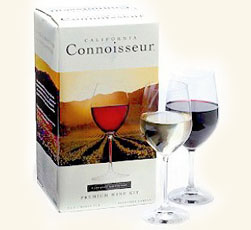 I just made 30 bottles of Cabernet Sauvignon California Connoisseur. I did all what the instructions said for the 28 days. The target was ok at 0.995 at the end. I omitted packets #4 and #5 (potassium Sorbate & Fining Agent ) My question is, my wine seems to be a little light to the taste, but letting it rest after opening did give it more body. Also laying the bottles on its side shows some sediment inside the bottle yet it was clear when I bottled it. What did I do wrong ?
I just made 30 bottles of Cabernet Sauvignon California Connoisseur. I did all what the instructions said for the 28 days. The target was ok at 0.995 at the end. I omitted packets #4 and #5 (potassium Sorbate & Fining Agent ) My question is, my wine seems to be a little light to the taste, but letting it rest after opening did give it more body. Also laying the bottles on its side shows some sediment inside the bottle yet it was clear when I bottled it. What did I do wrong ?
Name: Daniel B.
State: FL
Hello Daniel,
A wine having a light flavor is typically a symptom of trying to drive the alcohol level up with more sugar. This will bring the wine out of balance giving it a watery impression. When you let a wine sit open for a few minutes before drinking, as you did, it allows time for the aromas or bouquet to develop and release. This is done quite often with some wine, particularly red wines. The addition of these aromas will give the impression that the wine has more flavor.
As to having sediment in the wine bottles, this is a direct result of not adding the fining agent as you had indicated. It is very common for a newly made wine to look visually clear before it is actually done clearing. That is why a “fining agent” provided with these kits — to drop out what you can’t see.
Happy Winemaking,
Ed Kraus
———————————————————————————————————
Ed Kraus is a 3rd generation home brewer/winemaker and has been an owner of E. C. Kraus since 1999. He has been helping individuals make better wine and beer for over 25 years.
Category Archives: Wine
Can I Combine two 10 Liter Wine Kits?
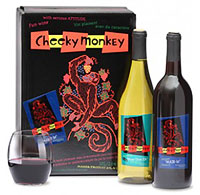 Can l combine two 10 liter wine kits (cab.franc) to one single batch; l do not want to dilute the juice with too much water. Will this work ?
Can l combine two 10 liter wine kits (cab.franc) to one single batch; l do not want to dilute the juice with too much water. Will this work ?
Your answer would indeed be very appreciative.
Name: Richard
State: California
Hello Richard,
The answer to your question is no. The issue is the acid in the juice. Your wine would have double the acidity making is very sharp tasting. I strongly suggest that you only use one wine making kit per 6 gallons. You will be very surprised at the amount of body and flavor your wine will have when using these wine making kits in this way.
Thank you for your question,
Ed Kraus
———————————————————————————————————
Ed Kraus is a 3rd generation home brewer/winemaker and has been an owner of E. C. Kraus since 1999. He has been helping individuals make better wine and beer for over 25 years.
My Watermelon Wine Keeps Fermenting
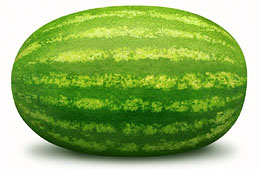 I have a batch of watermelon wine that seems to keep on working. It seems there is no end to its fermentation. Should I add campden tablets to make it stop or do I just wait?
I have a batch of watermelon wine that seems to keep on working. It seems there is no end to its fermentation. Should I add campden tablets to make it stop or do I just wait?
Name: Bill P.
State: Connecticut
Bill,
It sounds like you have a stalled fermentation — one that just won’t get up and get going. I would suggest the you go over the “Top 10 Reasons For Fermentation Failure” that are listed on our website. See which on of these 10 reasons fits your scenario. We have found that these 10 reasons cover 95% of the issues we run across. Once you know what the problem is you can fix it and allow the fermentation to finish more quickly.
As far as adding Campden Tablets, I would strongly recommend against using it at this point in the wine making process. Campden Tablets are not that effective at stopping a fermentation. They will give the fermentation activity a “punch in the gut”, then the fermentation will typically pick up again, just enough to be annoying. You are much better off letting the fermentation finish then add the Campden Tablets once the wine clears.
Best Wishes,
Ed Kraus
———————————————————————————————————
Ed Kraus is a 3rd generation home brewer/winemaker and has been an owner of E. C. Kraus since 1999. He has been helping individuals make better wine and beer for over 25 years.
When is the Best Time to Drink Red Wine from a Kit?
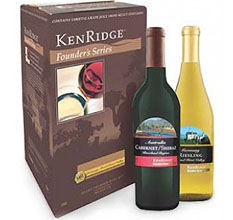 For the past year a group of us have been making red wine from kits. We began with a Tempranillo in May. Next we made a Super Tuscan which we bottled in Sept. This was followed by a Zinfandel which we bottled in Nov. In Dec. we will bottle a Syrah and an Amarone. Most of the kits say that these fines are good to drink in 3 months. Will these kit wines improve with age? Can any go a year or 2? How can we tell when they are mature? Will they all be different?
For the past year a group of us have been making red wine from kits. We began with a Tempranillo in May. Next we made a Super Tuscan which we bottled in Sept. This was followed by a Zinfandel which we bottled in Nov. In Dec. we will bottle a Syrah and an Amarone. Most of the kits say that these fines are good to drink in 3 months. Will these kit wines improve with age? Can any go a year or 2? How can we tell when they are mature? Will they all be different?
Name: Charlie J.
State: PA
Hello Charlie,
It depends on the wine making kit, and to some degree, the type of red wine. In general, the fuller or heavier the wine, the more it will take advantage of aging and the longer it will take to reach its full potential.
Most all wines will mature or improve with time, but some need more time than others. Once they reach maturity they then will typically plateau in quality for a period of time. This could be for a couple of years, some maybe 5 years. Then the wine will start to slowly degrade. This is something that happens very slowly over many years, not months. The point is once a wine reaches this plateau there is no “reason” to wait longer to drink the wine. This is no different than wines you would by commercially.
You may want to take a look at the blog post, “The Importance Of Aging Your Wine“. In this blog post, there is an aging chart for most of the brands we offer. You may want to use this a general guide.
Happy Winemaking,
Ed Kraus
———————————————————————————————————
Ed Kraus is a 3rd generation home brewer/winemaker and has been an owner of E. C. Kraus since 1999. He has been helping individuals make better wine and beer for over 25 years.
The 5 Steps Of Making Homemade Wine
There’s a lot of variation in how to make your own wine, however, the same basic steps apply regardless of what type of wine you make.
- Must preparation: For this step of how to make your own wine, the fruit or wine grapes are made into a mushy substance, known as the “must”. During this stage, sugar and acid levels must balance so that when following the wine recipe it leads to a well-balanced wine.
- Primary and Secondary Fermentation: During the primary fermentation, wine yeast converts sugar to alcohol and carbon dioxide. This is also known as aerobic fermentation, since the fermentation container is exposed to air. Primary fermentation lasts for 3 to 5 days, and accounts for around 70% of the entire fermentation activity. Secondary fermentation is much slower, lasting one or two weeks, and ferments the remaining 30% left unfermented by primary fermentation. This is also known as anaerobic fermentation, since the fermentation container is closed off to air. This focuses the wine yeast on converting sugar to alcohol instead of multiplying.
- Racking & Aging: The purpose of the racking step is to transfer the wine from one fermenter to another, leaving behind sediment in the bottom of the first fermenter and out of the finished wine. You may rack wine multiple times if there’s a lot of sediment to remove. Aging wine can occur over any time period, depending upon what type of wine you are making. Aging allows the wine to evolve and develop, which effectively alters the flavor, aroma, and taste of the wine. Typically, red wines require longer aging than white wines, in order to develop the more complex characteristics that are unique to red wines.
- Clarification and Stabilization: The clarification step acts to further “fine” the wine from sediments by adding finings or further racking to remove solid particles and sediment. Changes in temperature, humidity, or other environmental factors can cause chemical reactions in wine, which sometimes results in the precipitation of solids. Stabilizing the wine using chemical or temperature treatments will prevent your wine from experiencing this precipitation when exposed to less-than-ideal conditions.
- Bottling and Storing: The last step in this overview on how to make your own wine, comes after you’ve finished your delectable wine. Bottle it to protect it from overexposure to air, light, and other environmentally detrimental conditions. Finally, you want to store your wine under “cellar conditions” in order to preserve the life of your wine. Lay the bottle on its side, keep it in the dark, and store around 55°F.
———————————————————————————————————
Ed Kraus is a 3rd generation home brewer/winemaker and has been an owner of E. C. Kraus since 1999. He has been helping individuals make better wine and beer for over 25 years.
Synthetic Or Natural Wine Bottle Corks: A Corker's Conundrum
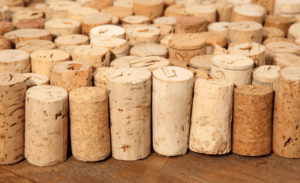 There’s a lot of debate regarding what type of closure you should be using to bottle your homemade wine. Understanding the qualities of each type of closure and how they fit in with the style of wine you intend to create will allow you to make an informed decision and give you confidence that you are selecting the perfect wine bottle closure for your homemade wine.
There’s a lot of debate regarding what type of closure you should be using to bottle your homemade wine. Understanding the qualities of each type of closure and how they fit in with the style of wine you intend to create will allow you to make an informed decision and give you confidence that you are selecting the perfect wine bottle closure for your homemade wine.
Two of the most common types of wine bottle closures are natural cork and synthetic cork.
Natural wine bottle cork comes from the bark of the cork tree, which is indigenous to Spain and Portugal. They do not kill the tree in order to harvest the cork, but instead they simply strip the bark off the tree, which subsequently regenerates new bark. In this way, the method can be considered renewable and environmentally friendly. Natural cork is also the oldest method of bottle closure, and has been widely used and accepted for hundreds of years.
Natural cork allows small amounts of oxygen into the wine, which is beneficial during the aging process. One problem with this is that the amount of oxygen let in is extremely variable from cork to cork, and one can never be sure their wine is being exposed to too much air. You always run the risk of having a “corked” bottle of wine, caused by TCA (2,4,6-trichloroanisole), which is produced by fungus living in the natural cork. Finally, natural cork can sometimes crumble when trying to remove it, which leaves undesirable chunks of cork floating around in your glass of wine.
Synthetic corks are alternatives to natural cork that have been picking up a lot of steam in recent years. One concern about synthetic corks is that not enough oxygen is allowed through the cork and into the wine; however, there is currently ongoing research that is making progress in alleviating this issue.
One benefit of synthetic cork is that you’ll never have a wine that is suffering from cork taint. Also, synthetic cork can be very easy to remove from the bottle, and you never have to worry about crumbling or breaking. Finally, synthetic corks are recyclable, so you don’t have to worry about being unfriendly to the environment when you use this alternative wine bottle cork.
Since over 90% of wines are designed to be consumed in their youth, the issue of synthetic cork subpar breathability is no longer an issue. Oxygen transfer is extremely important in the aging of wines, however, if you are making a wine that’s designed to be consumed immediately, then buying synthetic corks may just be the way to go!
———————————————————————————————————
Ed Kraus is a 3rd generation home brewer/winemaker and has been an owner of E. C. Kraus since 1999. He has been helping individuals make better wine and beer for over 25 years.
Need A Gift Idea? How About A Wine Making Book!
 The holidays are about 6 weeks away: have you started shopping for your friends and family? Are you looking to add to your own gift list? Here are some wine making book suggestions for you to think about now for the home wine maker that is near and dear to your heart. Don’t celebrate the holidays? It’s never the wrong time to surprise an aspiring enologist with a wine making book!
The holidays are about 6 weeks away: have you started shopping for your friends and family? Are you looking to add to your own gift list? Here are some wine making book suggestions for you to think about now for the home wine maker that is near and dear to your heart. Don’t celebrate the holidays? It’s never the wrong time to surprise an aspiring enologist with a wine making book!
Techniques in Home Winemaking:
The Comprehensive Guide to Making Chateau-Style Wines
by Daniel Pambianchi: Popular among home wine makers, this wine making book provides instructions for making wine that is written in a straight forward way that both novices and experts can understand and covers every aspect of the wine making process. It provides technical explanations of the science behind the art, but not so technical that a novice would feel overwhelmed.
The Joy of Home Winemaking
by Terry A. Garey: This wine making book is popular among beginners, though is certainly a good reference for experts. Written in an easy, comprehensive, and often humorous manner, this wine making book adds adventure and variety to your home wine making experience. Want to know how to make a cherry pie wine or rhubarb champagne? This book has the recipe for fun with home wine making!
The Home Winemaker’s Companion:
Secrets, Recipes, and Know-How for Making 115 Great-Tasting Wines
by Gene Spaziani: This wine making book is great for beginners who aren’t looking for a technical explanation for the wine making process. If you are a more advanced home wine maker, this may not be the best wine making book for you. Looking for recipes that contain many of the same base ingredients for easy wine making? You may want to put this book on your list!
———————————————————————————————————
Ed Kraus is a 3rd generation home brewer/winemaker and has been an owner of E. C. Kraus since 1999. He has been helping individuals make better wine and beer for over 25 years.
Use Liqueur Flavorings To Pack More Flavor Into Your Wines
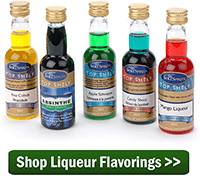 Hi… Just wondering if your liqueur flavorings could be added to a fruit wine.. for a little stronger flavor… Our peach, this year, is not real “peachy”…. and wondered if this would give it a flavor boost…
Hi… Just wondering if your liqueur flavorings could be added to a fruit wine.. for a little stronger flavor… Our peach, this year, is not real “peachy”…. and wondered if this would give it a flavor boost…
Thank you,
Sandy M.
—–
Hello Sandy,
These liqueur flavorings where originally intended to be used for taking an inexpensive spirit such as everyday Vodka and turning it into something special such as Amoretto, French Brandy, Peach Schnapps or dozens of other popular liqueurs. They are used in conjunction with thickening and/or sweetening Liqueur Bases to produce these lush cordials.
Having said this, we discovered long ago that these bottles of liqueur flavorings can do great things when added to a homemade fruit wine. Quite often we recommend using them to add additional flavor and aroma to homemade fruit wines that are in the situation you described. So yes, absolutely you can use these liqueur flavorings to enhance your wines flavor. This is one of my favorite wine making tips because it’s so easy to do.
One bottle is probably the max you will want to use in a 5 or 6 gallon batch of fruit wine, and sometimes even less than this is best. These little bottles of contain an unexpected amount of flavor in them. Adding too much to your homemade wine can be worse than adding none at all. Doing so can bring an unwanted bitter astringency to the wine that will later need to be masked with sweetening of some sort.
Starting with a half of bottle of liqueur flavoring in 5 gallons of wine is a safe way to go about it. You can use a measuring syringe to help you control the amount you are actually adding to the wine.
You can also expect somewhat of a delayed reaction with these flavoring. There full affect is not immediate, particularly the aroma. They need some time to mingle with the wine before their full affect can be experienced. I usually let the wine sit overnight before making and determinations.
Happy Winemaking,
Customer Service
———————————————————————————————————
Ed Kraus is a 3rd generation home brewer/winemaker and has been an owner of E. C. Kraus since 1999. He has been helping individuals make better wine and beer for over 25 years.
New Wine Bottle Corker: Bottle Wine Like A Pro!
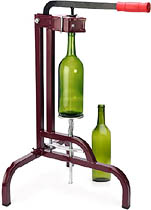 We’ve just added a new corker to our website, and it’s one that we are very excited about. It’s called the Winery-Grade Floor-Corker. Not only is it a quality corker, it’s a corker that we’re able to offer at a deceptively-low price of $69.95!
We’ve just added a new corker to our website, and it’s one that we are very excited about. It’s called the Winery-Grade Floor-Corker. Not only is it a quality corker, it’s a corker that we’re able to offer at a deceptively-low price of $69.95!
It’s a floor-model style corker that stands 30 inches tall. What this means is that you are able to stand over it to gain greater leverage. Because it is so well designed and constructed, it can easily insert size #9 cork with very little effort — both natural wine cork stoppers and the denser synthetic corks.
It’s fast and simple to use. With the lever all the way up, just drop a cork into the chamber in the corker’s head. Then place a wine bottle on the spring-loaded table.
As you push the lever down two things begin to happen at the same time:
- The wine bottle table locks into place, securing the wine bottle against the bottom of corker’s head.
- The corker slowly starts to compress the cork with its jaws.
As the lever goes all the way down it smoothly plunges the compressed cork into the wine bottle.
This floor-corker is great for the home winemaker who needs more than a handle-held corker. It allows them to cork a good size batch without straining their hands. But this is also a great corker for bottling larger batches. It can cork wine bottles at a very brisk pace. And if you want to put it into overdrive, you can use it as a two-man unit: one person loads and unloads the wine bottle; the other person loads the cork and plunges the lever.
You can find our more about this Winery-Grade Floor-Corker on our website. We have plenty in stock. And remember, as an added boost to this already great value, we’ll get it to your front door at no charge. Shipping is absolutely free!
———————————————————————————————————
Ed Kraus is a 3rd generation home brewer/winemaker and has been an owner of E. C. Kraus since 1999. He has been helping individuals make better wine and beer for over 25 years.
Watermelon Wine Help!
I’m making watermelon wine and would like to give it strong melon flavor. I have been racking my brain thinking how to do this since you can’t boil it down, because it said to kill the flavor. So after giving it a lot of thought, this is what i was thinking, can I add a finshed bottle, of the same type of wine i’m making would this help or hurt . 2nd idea is to dehydrate the watermelon and make watermelon power. Then take the powder and add it in the place of, or with the sugar. and use fresh melon juice has the recipe calls for. keep in mine im trying to make a powerful melon taste but dry not to sweet. Thank you for your time to help a noobie like me .
Name: Jason
State: nc
